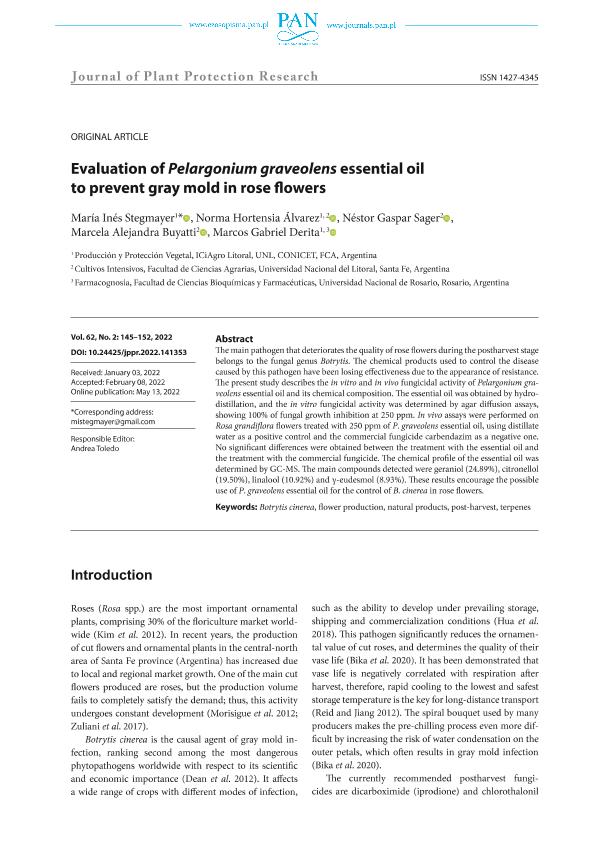Artículo
Evaluation of Pelargonium graveolens essential oil to prevent gray mold in rose flowers
Stegmayer, María Inés ; Alvarez, Norma Hortensia
; Alvarez, Norma Hortensia ; Sager, Néstor Gaspar; Buyatti, Marcela Alejandra; Derita, Marcos Gabriel
; Sager, Néstor Gaspar; Buyatti, Marcela Alejandra; Derita, Marcos Gabriel
 ; Alvarez, Norma Hortensia
; Alvarez, Norma Hortensia ; Sager, Néstor Gaspar; Buyatti, Marcela Alejandra; Derita, Marcos Gabriel
; Sager, Néstor Gaspar; Buyatti, Marcela Alejandra; Derita, Marcos Gabriel
Fecha de publicación:
05/2022
Editorial:
Polska Akademia Nauk
Revista:
Journal of Plant Protection Research
ISSN:
1427-4345
e-ISSN:
1899-007X
Idioma:
Inglés
Tipo de recurso:
Artículo publicado
Clasificación temática:
Resumen
The main pathogen that deteriorates the quality of rose flowers during the postharvest stage belongs to the fungal genus Botrytis. The chemical products used to control the disease caused by this pathogen have been losing effectiveness due to the appearance of resistance. The present study describes the in vitro and in vivo fungicidal activity of Pelargonium graveolens essential oil and its chemical composition. The essential oil was obtained by hydro-distillation, and the in vitro fungicidal activity was determined by agar diffusion assays, showing 100% of fungal growth inhibition at 250 ppm. In vivo assays were performed on Rosa grandiflora flowers treated with 250 ppm of P. graveolens essential oil, using distillate water as a positive control and the commercial fungicide carbendazim as a negative one. No significant differences were obtained between the treatment with the essential oil and the treatment with the commercial fungicide. The chemical profile of the essential oil was determined by GC-MS. The main compounds detected were geraniol (24.89%), citronellol (19.50%), linalool (10.92%) and γ-eudesmol (8.93%). These results encourage the possible use of P. graveolens essential oil for the control of B. cinerea in rose flowers.
Palabras clave:
BOTRYTIS CINEREA
,
FLOWER PRODUCTION
,
NATURAL PRODUCTS
,
POST-HARVEST
,
TERPENES
Archivos asociados
Licencia
Identificadores
Colecciones
Articulos (ICIAGRO-Litoral)
Articulos de INSTITUTO DE CIENCIAS AGROPECUARIAS DEL LITORAL
Articulos de INSTITUTO DE CIENCIAS AGROPECUARIAS DEL LITORAL
Citación
Stegmayer, María Inés; Alvarez, Norma Hortensia; Sager, Néstor Gaspar; Buyatti, Marcela Alejandra; Derita, Marcos Gabriel; Evaluation of Pelargonium graveolens essential oil to prevent gray mold in rose flowers; Polska Akademia Nauk; Journal of Plant Protection Research; 62; 2; 5-2022; 145-152
Compartir
Altmétricas



